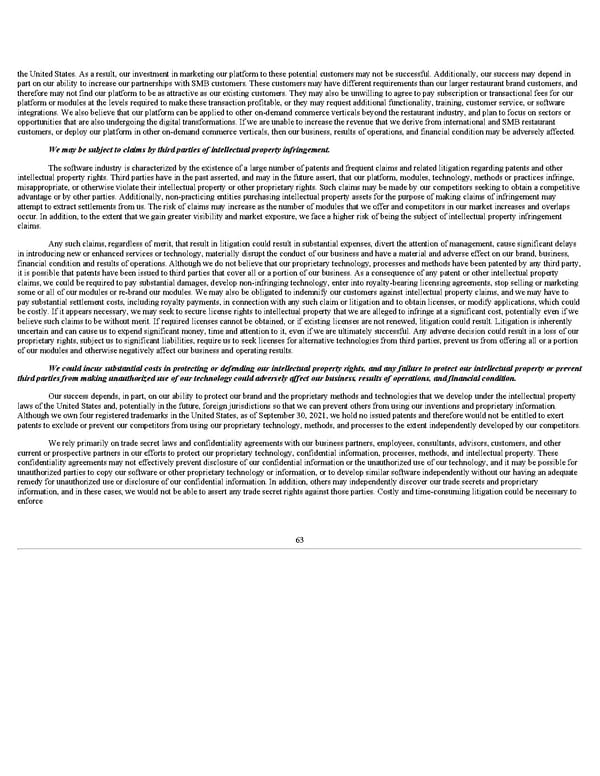the United States. As a result, our investment in marketing our platform to these potential customers may not be successful. Additionally, our success may depend in part on our ability to increase our partnerships with SMB customers. These customers may have different requirements than our larger restaurant brand customers, and therefore may not find our platform to be as attractive as our existing customers. They may also be unwilling to agree to pay subscription or transactional fees for our platform or modules at the levels required to make these transaction profitable, or they may request additional functionality, training, customer service, or software integrations. We also believe that our platform can be applied to other on-demand commerce verticals beyond the restaurant industry, and plan to focus on sectors or opportunities that are also undergoing the digital transformations. If we are unable to increase the revenue that we derive from international and SMB restaurant customers, or deploy our platform in other on-demand commerce verticals, then our business, results of operations, and financial condition may be adversely affected. We may be subject to claims by third parties of intellectual property infringement. The software industry is characterized by the existence of a large number of patents and frequent claims and related litigation regarding patents and other intellectual property rights. Third parties have in the past asserted, and may in the future assert, that our platform, modules, technology, methods or practices infringe, misappropriate, or otherwise violate their intellectual property or other proprietary rights. Such claims may be made by our competitors seeking to obtain a competitive advantage or by other parties. Additionally, non-practicing entities purchasing intellectual property assets for the purpose of making claims of infringement may attempt to extract settlements from us. The risk of claims may increase as the number of modules that we offer and competitors in our market increases and overlaps occur. In addition, to the extent that we gain greater visibility and market exposure, we face a higher risk of being the subject of intellectual property infringement claims. Any such claims, regardless of merit, that result in litigation could result in substantial expenses, divert the attention of management, cause significant delays in introducing new or enhanced services or technology, materially disrupt the conduct of our business and have a material and adverse effect on our brand, business, financial condition and results of operations. Although we do not believe that our proprietary technology, processes and methods have been patented by any third party, it is possible that patents have been issued to third parties that cover all or a portion of our business. As a consequence of any patent or other intellectual property claims, we could be required to pay substantial damages, develop non-infringing technology, enter into royalty-bearing licensing agreements, stop selling or marketing some or all of our modules or re-brand our modules. We may also be obligated to indemnify our customers against intellectual property claims, and we may have to pay substantial settlement costs, including royalty payments, in connection with any such claim or litigation and to obtain licenses, or modify applications, which could be costly. If it appears necessary, we may seek to secure license rights to intellectual property that we are alleged to infringe at a significant cost, potentially even if we believe such claims to be without merit. If required licenses cannot be obtained, or if existing licenses are not renewed, litigation could result. Litigation is inherently uncertain and can cause us to expend significant money, time and attention to it, even if we are ultimately successful. Any adverse decision could result in a loss of our proprietary rights, subject us to significant liabilities, require us to seek licenses for alternative technologies from third parties, prevent us from offering all or a portion of our modules and otherwise negatively affect our business and operating results. We could incur substantial costs in protecting or defending our intellectual property rights, and any failure to protect our intellectual property or prevent third parties from making unauthorized use of our technology could adversely affect our business, results of operations, and financial condition. Our success depends, in part, on our ability to protect our brand and the proprietary methods and technologies that we develop under the intellectual property laws of the United States and, potentially in the future, foreign jurisdictions so that we can prevent others from using our inventions and proprietary information. Although we own four registered trademarks in the United States, as of September 30, 2021, we hold no issued patents and therefore would not be entitled to exert patents to exclude or prevent our competitors from using our proprietary technology, methods, and processes to the extent independently developed by our competitors. We rely primarily on trade secret laws and confidentiality agreements with our business partners, employees, consultants, advisors, customers, and other current or prospective partners in our efforts to protect our proprietary technology, confidential information, processes, methods, and intellectual property. These confidentiality agreements may not effectively prevent disclosure of our confidential information or the unauthorized use of our technology, and it may be possible for unauthorized parties to copy our software or other proprietary technology or information, or to develop similar software independently without our having an adequate remedy for unauthorized use or disclosure of our confidential information. In addition, others may independently discover our trade secrets and proprietary information, and in these cases, we would not be able to assert any trade secret rights against those parties. Costly and time-consuming litigation could be necessary to enforce 63
 Q3 2021 10Q Page 68 Page 70
Q3 2021 10Q Page 68 Page 70